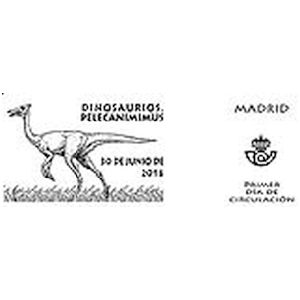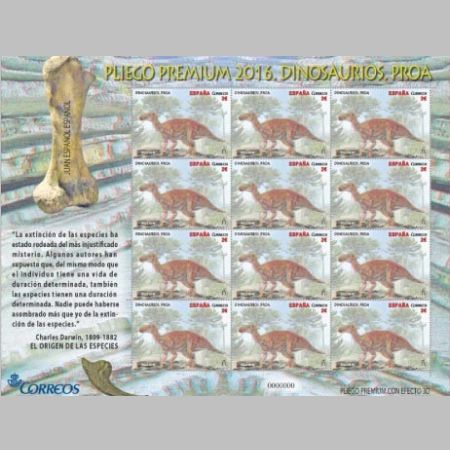Spain 2016 "Dinosaurs (2nd)"
| <prev | back to index | next> |
| Issue Date | 30.06.2016 |
| ID | Michel: 5077-5080; Scott: ; Stanley Gibbons: 5068-5071; Yvert et Tellier: 4782-4785; Category: pR |
| Design | Ramiro Undabeytia |
| Stamps in set | 4 |
| Value |
€2 Europelta €2 Pelecaniminus €2 Proa €2 Turiasaurus |
| Emission/Type | commemorative |
| Issue place | Madrid |
| Size (width x height) | 57.6 mm x 40.9 mm |
| Layout | Sheets of 16 and sheet of 12
stamps (Anquilosaurus) |
| Products | |
| Paper | gummed |
| Perforation | 13x13 |
| Print Technique | Offset, scales texture, R.A., phosphorescence, 3D |
| Printed by | RCM-FNMT |
| Quantity | 250.000 each stamp |
| Issuing Authority | Correos Y Telegrafos SA |

On June 30th, 2016, the Post Authority of Spain issued the second stamps of Dinosaurs (first set issued in 2015). The set contain four stamps, each one printed with different technique: scales texture, Augmented Reality, phosphorescence, 3D and special glasses, which allows to some of the effects.
Distinguished from stamps of 2015 when all shown dinosaurs were well known to wide public: Ankylosaurus, Triceratops, Tyrannosaurus, Diplodocus, this year only "local" dinosaurs were depicted.
"Four new stamps shows the images of these some creatures that disappeared from Earth more than 65 million years ago. Dinosaurs who star in the series this year are: Europelta, which is printed with the technique called lenticular printing, the Pelecaniminus whose image has been printed with holographic ink, the dinosaur known as Proa presented in a Premium Pliego 3D and finally Turiasaurus, printed with thermo chromic ink that changes color when subjected to temperature changes.
 |
| MiNr.: , Scott: |
 |
| MiNr.: , Scott: |
The Proa is an unusual basal iguanodóntido whose unique feature is the presence of a pre-dental single peak in their group.
Seems that it was herbivorous and measured seven to eight meters in length.
He lived in the mid-Cretaceous period some 112 million years ago and its remains were found at the lignite mine Santa Maria in Ariño (Teruel) in 2010.
 |
| MiNr.: , Scott: |
 |
| MiNr.: , Scott: |
The only place where its fossils are found is Cuenca.
Its average length ranges of two meters and its weight could reach 25 kilos.
This ornitomimosauriano had a long beak like his head and had a bag underneath, like the pelicans, perhaps, to keep capturing prey.
He had more teeth than other members of their species, particularly about 220. At the top of his head protruded a small ridge and is believed to be omnivorous.
Turiasaurus was a sauropod with large and sturdy limbs that lived in the late Jurassic period about 145 million years ago. It seems that the Turiasaurus riodevensis could weigh 40 tons and measuring about 30 meters long, exceeding the size of any dinosaur found in Europe and ranking among the largest supersaurópodos the world."
Carmen Alvarez Casanova
Products and associated philatelic items
| First-Day-of-Issue Postmark | |||
 |
 |
 |
 |
| FDC | Mini-Sheet | |
 |

|
|

|
References
Correos Spain| <prev | back to index | next> |